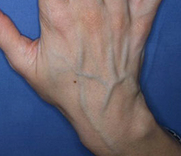|
As discussed in the prior Q&A, blood is composed of plasma and cells, the latter being mostly erythrocytes (RBC's). Erythrocytes are red due to the presence of hemoglobin (Hb), the metalloprotein responsible for oxygen transport. Hemoglobin is composed of four subunits, each composed of a protein chain and a non-protein heme group. Each heme group consists of an iron (Fe) ion surrounded by a heterocyclic porphyrin ring.
|
A common misconception is that the red color of blood is due to hemoglobin iron. The source of this myth likely originates from the fact that iron oxides (rust) have a reddish hue. In reality the reddish color of hemoglobin derives from the porphyrin ring to which the iron is bound, not the iron itself.
|
In the blood stream hemoglobin exists in two forms distinguished by the presence or absence of attached molecular oxygen. These are known as oxyhemoglobin (oxy-Hb) and deoxyhemoglobin (deoxy-Hb) respectively. Over 95% of hemoglobin in arterial blood is in the oxy-Hb form; the level in venous blood averages between 50-80%.
The colors of arterial and venous blood are different. Oxygenated (arterial) blood is bright red, while dexoygenated (venous) blood is dark reddish-purple. The difference is color results from the electronic state of the iron ion (ferrous vs ferric), which in turn influences the π → π* and n → π* electronic transitions of porphyrin and hence its optical characteristics. The commonly used pulse oximeter takes advantage of this color shift, comparing light absorption at 660 and 950 nm allowing calculation of percent of blood in the oxy-Hb state ("O2 sat").
|

If venous blood in a test tube is dark purple, why do veins appear blue?
The reason has to do with the way different light colors pass through the skin. In fair-skinned persons blue light is reflected at the skin surface, while red light penetrates more deeply. The dark blood in veins absorbs this red light so we see predominantly reflected blue light from the skin surface.
The reason has to do with the way different light colors pass through the skin. In fair-skinned persons blue light is reflected at the skin surface, while red light penetrates more deeply. The dark blood in veins absorbs this red light so we see predominantly reflected blue light from the skin surface.
Advanced Discussion (show/hide)»
No additional material yet. Check back soon!
References
Kienle A, Lilge L, Vitkin AI, et al. Why do veins appear blue? A new look at an old question. Appl Optics 1996; 35:1151-1160. (Maybe more than you wanted to know, but here it is).
Kienle A, Lilge L, Vitkin AI, et al. Why do veins appear blue? A new look at an old question. Appl Optics 1996; 35:1151-1160. (Maybe more than you wanted to know, but here it is).
Related Questions
What factors determine the MR appearance of blood?
What factors determine the MR appearance of blood?


